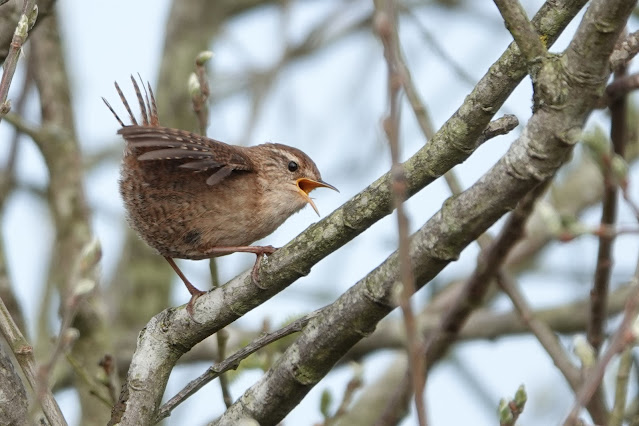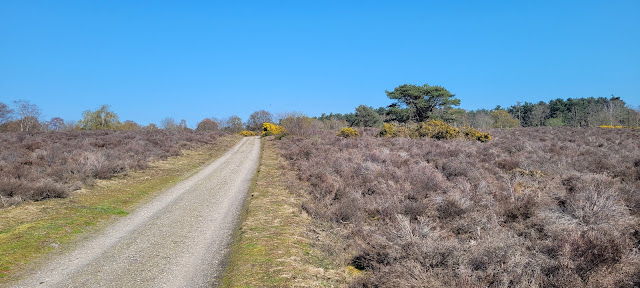A www.blueeyedbirder.com Suffolk adventure:It was a bit of a tortuous drive up to Lowestoft on Friday
morning and I had a short stop at Hen Reedbeds just to stretch my legs. Marsh Harriers were displaying and a Yellow
Wagtail flew over but it was cold and blowy and after looking at the lovely
Cowslips and some Bee-flies, I retreated to the warmth of the car and continued
onwards passing a Red Kite feeding in a garden in Wrentham on the way.
15th April:
We were meeting at 8am so Antony and I had a preliminary
look at Westleton Common in the hope of finding the first Nightingales of the
season. It was very chilly and grey but two males started up almost as soon as
we got out of the car which was a grand start.
One of them put on a fine show in a still bare Sallow with full vibrato
song, loud huweets and growling croaks.
 |
| Nightingale |
This sandy site is covered in clumps of glorious Gorse and
almost bare sandy areas which were covered in the most luxurious carpet of
Cladonia Reindeer Lichen. It was too
cold for any insects whatsoever!
Willow Warbler, Chiffchaff and Blackcap were in song and a
single Redwing was a good mid-April surprise.
Our subsequent walk around Minsmere may have been cool to
start with but the woodland was alive with singing Blue, Great and Coal Tits,
singing Treecreepers and noisy Great Spotted and Green Woodpeckers while
Goldfinches and Greenfinches were in song and display from the hidden canopy. The number of Grey Squirrels was terrifying! Through the
trees we could hear the cacophony of birds on the scrapes with Black-headed and
Med Gulls, Sandwich Terns, Avocets, Redshanks, Oystercatchers and even Barnacle
Geese all audible while Sand Martins fizzed overhead.
.jpeg) |
| A fine cock Pheasant - note the small Ticks in his wattles - Antony Wren |
.jpeg) |
| Pheasant - Antony Wren |
The Bittern Hide turned out to be a prime stop and although
we did not see a Bittern from here we heard several booming in all directions
while invisible Sedge Warblers energetically proclaimed their arrival and Cetti’s
Warblers hopped around in the open below us and gave exceptional views.
Two drake and a female Garganey whizzed towards the scrapes
and the usual other duck were all seen on the move. Bearded Tits were very vocal and we all picked
up the odd one whizzing over the reed tops but a Water Rail required quick reactions
as it flew across the pool below us. Marsh Harriers were constantly on view and Med Gulls drifted
over with the Black-heads.
 |
| Marsh Harrier - Philippa Carr |
Back into the
woods where territorial Chiffchaffs acted like we were not there and a
Firecrest sang from further back in the pines but was out of ear for most of
the crew.
 |
| Chiffchaff |
The common below Whin Hill held no Wheatears but ten Jays
noisily moved around the edges with a couple doing fantastic Buzzard mewing
while up above five of the real thing did likewise with a Sparrowhawk in the
same thermal – yes it was warming slightly!
.jpeg) |
| Ten Spot Ladybird - Antony Wren |
.jpeg) |
| Wood Ant - Antony Wren |
.jpeg) |
| Red Deer run - Antony Wren |
 |
| Buzzards |
 |
| Buzzards - such different profiles |
A Willow Warbler and several Sedge Warblers were encountered
just before the Island Mere Hide and a single Reed Warbler was quietly chuntering
away too. Sometimes it is the commonest
bird that puts on the best display and a pumped up male Wren gave a storming
performance as he enticed his new lady friend to come and join him. It worked and the two left together.
.jpeg) |
| Wren - Antony Wren |
 |
| Wren - what a little stunner |
Island Mere added Tufted Ducks and both Great Crested and
Little Grebes and better views of Reed Buntings and Bearded Tits but although
we could hear Bitterns we took what felt like an age to actually see one as it
flew in from the east and dropped out of view.
Marsh Harriers were constant companions with one red tagged male being
especially obliging in his hunting circuit.
The whiteboard informed us of a new species of Gallinago being around
and we soon found two Wesley’s in the cut area out front.
.jpeg) |
| Marsh Harrier - Antony Wren |
.jpeg) |
| Marsh Harrier and Carrion Crow - Antony Wren |
 |
| two Wesley’s Snipe |
Retracing our steps we headed down to the West and South hides
and although the light was in out faces we still had great views of the Gulls
and Terns and found an adult Kittiwake and several 1st-summer Common
Gulls and the usual ‘big three’ amongst them. Single of Turnstone, Ringed Plover and Curlew were
the only other waders noted. The
wall of sound was wondrous to hold and being told by oncoming birders that ‘it
was very quiet’ is always disappointing.
 |
| Kittiwake, seven Black-headed and three 1st-summer Common Gulls |
 |
| Sandwich Terns |
More Meds ‘cawwwwwed’ over us with glossy black heads and
blood red bills and a Little Egret in his finery went the other way along with
our first Grey Heron.
 |
| adult Med Gulls |
 |
| Little Egret |
Down at the sluice we found a single Swallow and the warming
concrete had 24-Spot Ladybirds, Zebra Jumping Spider and a few Chironomid
Midges basking. As expected the sea was home
to nothing bar a few large gulls but the blooming Gorse with its wall of
coconut scent produced Linnets and Goldfinches and a couple of dapper Stonechats
but no Dartford Warblers or Adders.
.jpeg) |
| Zebra Jumping Spider - Salticus scenicus - Antony Wren |
.jpeg) |
| 7-spot Ladybird - Antony Wren |
 |
| 24-spot Ladybird |
.JPG) |
| Claytonia perfoliata - a non native growing well in the dunes |
 |
| Stonechat |
 |
| Stonechat |
 |
| Stonechat |
 |
| Sea Kale |
The open viewing platform gave us even closer views of a
second batch of Sandwich Terns noisily erickkkking just in front and amongst
the Meds and Black-headed Gulls I found a stunning full adult hybrid between
the two. It was a cracking bird that
squarely sat between the two parents with a perfectly shaped BHG body and beak but
with rich blood red Med Gull legs and bill. The hood was black and went further
down the nape than on a BHG but not as far as a Med. The open wing was pointed
like a BHG and with a slightly less obvious BHG underwing pattern which was
less contrasting due to the slightly paler upperparts. There is always something to learn.
 |
| Sandwich Terns |
 |
| 2s Med Gull |
 |
| Black-headed x Med Gull |
 |
| Black-headed x Med Gull |
 |
| Black-headed x Med Gull |
 |
| Black-headed x Med Gull |
 |
| Med Gulls |
 |
| Med Gull |
Continuing around we failed to pick up the Grasshopper
Warbler but did get stupendously long flight views of a Bittern that flew over
the North Bank gleaming ginger in the sunshine. There were no Stone Curlews to
be found but a smart Halictus rubicundus was seen near where the Bee-wolves will
appear later and a couple of Peacocks zoomed around. The Garganey was not visible from the North
Hide but a Blackcap was singing with a beak full of nest material just outside
and I found seven Lapwing nests on the marsh in front. A Goldcrest followed us back down the path.
 |
| Bittern - Philippa Carr |
 |
| Halictus rubicundus |
A few minutes with the Sand Martin colony (and again no
Adders) and time for a look at the Ant-lion pits before lunch. Most were small dimples in the sand but one
was big and deep and occasionally showed signs of an inhabitant inside.
.jpeg) |
| Sand Martins - Antony Wren |
 |
| Ant-lion pit |
Buzzards and Marsh Harriers circled over as we ate and a Pine
Ladybird joined the invert list.
 |
| Pine Ladybird |
Onto Westleton Heath where two male Woodlarks greeted our
arrival with an appropriate serenade and Antony’s Emperor Moth lure attracted several
stunning males in quick succession, one of which posed rather nicely. A slow walk up the main path in now warmish
and calming conditions raised my hopes of finding Dartford Warbler but I have
had real trouble with the species up here this year. Thankfully all was good and we found a very
active pair. There was a little bit of
song and a couple of display flights from the male and he looked especially resplendent
decked out in vinous claret and steely blue-grey.
 |
| Emperor Moth |
 |
| Dartford Warbler |
 |
| Dartford Warbler - Philippa Carr |
.jpeg) |
| Flint Eastwood - Antony Wren |
Several pairs of Stonechat were seen and the males were
counter singing their thin reedy notes off each other. A single disappearing Yellowhammer and the
distant notes of a Nightingale were the only other birds but we did find a
couple of small Dor Beetles of some description, a Spider Hunting Wasp and a mating pair of Gonia
picea – a fly with eyes that are spaces miles apart in both sexes!
 |
| Stonechat |
.JPG) |
| Spider Hunting Wasp - Anoplius viaticus |
 |
| Dor Beetle |
 |
| Gonia picea |
A failed attempt at the Westleton Common Nightingales
followed as we were a little too early so it was time for a last orders coffee
at Dunwich Beach café during which time Antony found a chunky adult female Hen
Harrier quartering Dingle Marshes which was areal bonus and another new bird
for several of the party. The Common
Scoter flock was still offshore but was too hazy to discern if there were still
any Velvets amongst them.
We wended up back on the Common where with a bit of
fieldcraft and patience good views were had of two of the there male
Nightingales as they sorted out the boundaries of their territories. It was a pleasant way to finish of what
actually felt like a proper spring day.
.jpeg) |
| Sallow - Antony Wren |

.jpeg)
.jpeg)


.jpeg)
.jpeg)
.jpeg)


.jpeg)

.jpeg)
.jpeg)





.jpeg)
.jpeg)

.JPG)














.jpeg)





.jpeg)

.JPG)


.jpeg)












.jpg)




.JPG)


.JPG)







.jpeg)
No comments:
Post a Comment